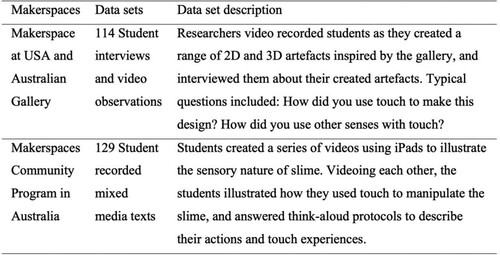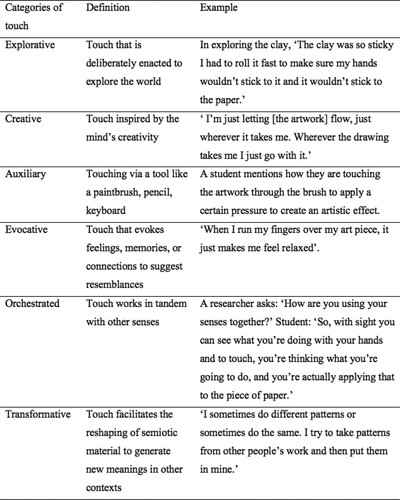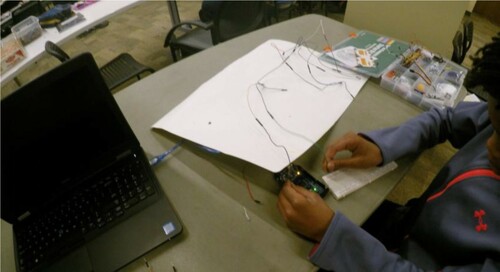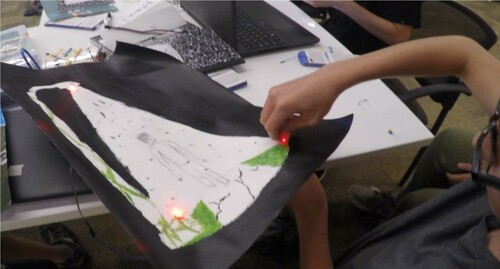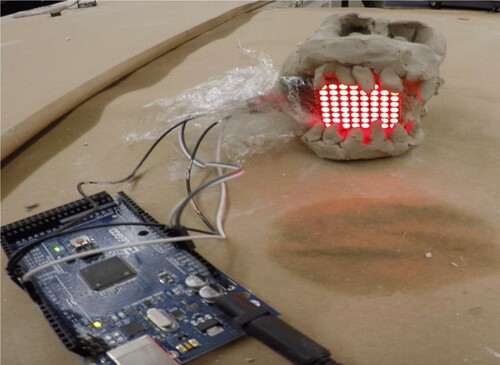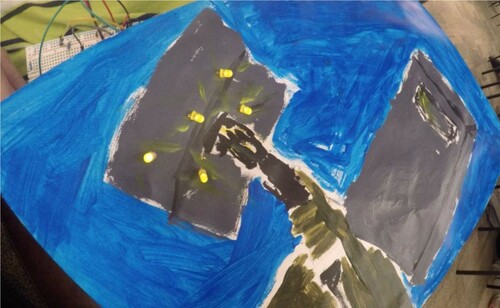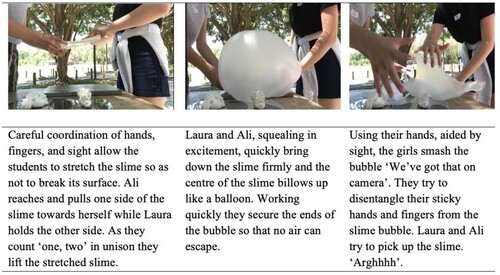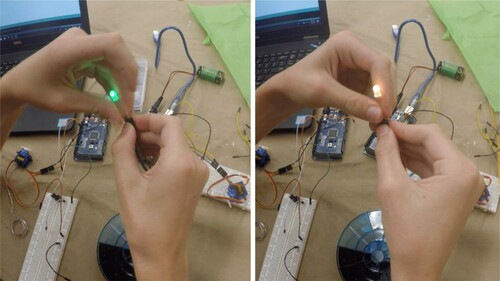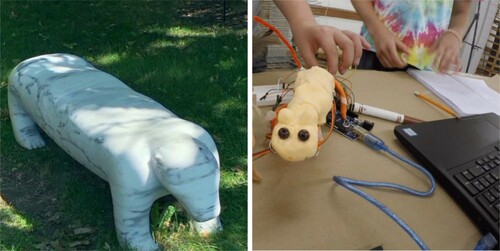ABSTRACT
This research examined the role of touch in creative media production in the context of educational and community makerspaces. Touch, while only recently explored in digital media production, is a crucial perceptive sense through which to experience the world, particularly in two- and three-dimensional making, and to explore texture, temperature, and vibration. As an embodied experience through the hands, fingers, and other body parts, touch affords knowledge and agency. This paper describes research that investigated how students, ages 8–13, used touch to make media. The findings illustrate how different touch types—explorative, creative, auxiliary, evocative, orchestrated, and transformative – emerged as central to the students’ media practices for making products. These findings are important given the recent applications of embodiment theory and its relevance to creative digital media making in education and society.
Introduction
Digital media production is a necessary skill that will be prominent in the future lifeworlds of many students. Participation in making has become one of the fastest growing areas of young people’s out-of-school activities, while education systems, in an effort to prepare students for creative digital cultures, have orientated toward greater use of technology in schools (Beavis Citation2014; Sefton-Green and Erstad Citation2017). The increased innovation of digital technologies, both in and out of school, has seen greater attention in research on the sensory nature of media practices called ‘sensory literacies’ (Mills Citation2016), like touch and body movement in walking with the camera (Mills, Comber, and Kelly Citation2013), and sensory interaction with literary apps or e-books (Mills, Unsworth, and Exley Citation2018). Touch, and its synergic use with vision and other senses, is recognised as fundamental to a growing range of digital practices (Crescenzi, Jewitt, and Price Citation2014; Jewitt, Leder Mackley, and Price Citation2021; Walsh and Simpson Citation2014).
However, until recently, the important role of the senses and the body, including touch, has been comparatively under-theorised in educational research and under-represented in the production of digital media (Walsh and Simpson Citation2014). Although touch has always constituted the human communicative repertoire, it has been subordinated to theories of textual practices in which vision is often positioned more centrally than other senses (Mills and Dooley Citation2019). Historically, touch, taste, and smell were referred to as the ‘lower senses’ – unimportant and discounted in the research in favour of the senses of vision and hearing (Classen Citation2012, xvi).
Theorists of sensory and embodiment studies point to the important role of the senses and the body in our everyday lives (Gibbs Citation2005; Howes Citation2014). Sensory theorists hold that our bodies, predominately through the senses, respond to, and are actively constituted in, our physical and social worlds (Mills and Dreamson Citation2015). The senses work in synchronicity in a sensory conjugation to perceive and communicate with the world (Duncum Citation2012; Howes Citation2014). This conjugation is known as sensory orchestration and occurs within the sensorium as ‘the sum total of our ways of sensing and perceiving the world’ (Duncum Citation2012, 183). In this way, touch operates with the support of vision, other sensorimotor functions, and material objects, to communicate and perceive the world (Gibbs Citation2005).
Theories of embodiment hold that the body, as a ‘source of experience and activity’, is capable of doing, and as a ‘source of knowledge and subsequently of agency’, is capable of knowing (Pink Citation2015, 26). Embodied knowing connects mind and body – embodied experiences shape cognition where ‘thinking, selfhood, and experiences’ are deeply rooted in kinaesthetic activity (Gibbs Citation2005; Haas and McGrath Citation2018, 127). In most education spaces, mind and body connections are channelled through senses like touch, sight, and other physical movements in doing and knowing. For example, teachers and students use touch and other body actions to enhance their understanding of scientific and mathematical knowledge through concrete modelling – which makes their learning body-based (Davidsen and Ryberg Citation2017; Wilson Citation2002).
This study attends to the subordination of touch in theories of media production and making by locating touch as a vital resource for embodied learning, communicating, and interacting with the world. The paper describes qualitative research in three makerspaces in the USA and Australia. The research had two aims: 1) to identify the types of touch that students used to create designs; and 2) to understand how touch was orchestrated with other multisensory resources to create designs. Video recordings and semi-structured and think-aloud interviews were collected from 116 students who engaged in media design in each of the three makerspaces. Think-aloud interviews were used because they allow participants to verbalise their thoughts while creating (Hevey Citation2020).
Makerspaces that employed a range of media production were deliberately chosen to explore how touch functioned across digital practices. Students in the study were engaged in making non-digital pattern prints, collages, and sculptures, and digitally enhanced objects, including slime videos (a popular genre on YouTube), technology-enhanced clay and recycled junk sculptures with moving parts, and kinetic e-paintings with embedded flashing lights coded using Arduino™ kits.
Touch in emerging educational landscapes
As noted previously, research that examines and observes the way that touch is used as a communicative and representational resource in education is still emergent. Touch has been researched in non-educational environments, including museums (Candlin Citation2010; Wood and Latham Citation2011), medical environments (Bezemer and Kress Citation2014), and the sporting field (Allen-Collinson and Hockey Citation2011). There is emerging research about touch and computers – for example, human sensitivity towards vibrational messages on touch screens (Chauvelin et al. Citation2014). In education, touch has been acknowledged as important in classroom communication patterns (Crescenzi, Jewitt, and Price Citation2014; Davidsen and Ryberg Citation2017), and as a strategic resource for tactile sensations during finger painting (Stanko-Kaczmarek and Kaczmarek Citation2016).
More recently research interest in touch reports touch as a prioritised practice to navigate modern digital technologies, like touch screens, keyboards, and game controls (Neumann and Neumann Citation2014; Walsh and Simpson Citation2014). However, there is a need to attend more consciously to the senses in digital media production, as touch has been observed to play an important part alongside creativity. For example, in a study on documentary film making it was noted that students drew on communication practices that were sensorial, embodied, and characterised by body movement (Mills, Comber, and Kelly Citation2013). The current paper generates new knowledge by analysing how students use touch to perceive, communicate, aesthetically express, and represent knowledge in makerspaces.
Makerspaces encompass new educational landscapes that call for the convergence of media practices that account for broadened varieties of bodily, digital, and non-digital communication and knowing (New London Group Citation2000). Activities in makerspaces are characterised by networked and multilayered knowledge forms that are constituted by new and emerging information and multimedia technologies, increasingly important to highly technologised societies (Marsh Citation2019). As novel learning environments, makerspaces draw on multiple means of representation through sensory literacies and embodied practices (Mills Citation2016).
Although ‘making and tinkering with technology’ has a long history in education, the availability of affordable and student-friendly computer hardware and software has seen it prioritised recently (Perrotta, Bailey, and Garside Citation2017, 553). Makerspaces – learning spaces that connect ‘STEM content areas and maker-centered learning’ – encompass this broader approach to learning in the context of changing fabrication technologies and the human desire to make (Schad and Monty Jones Citation2020, 66). In education, the importance of makerspaces lies in the strategic opportunities they provide for STEM, Art, and Digital Media related learning characterised by twenty-first century knowledge, including problem solving, creativity, and critical thinking skills (Keune and Peppler Citation2019). Makers rely on touch, together with other multisensory resources and materials, to filter phenomena, interpret environments, and to communicate (Rogers, Castree, and Kitchin Citation2013).
A phenomenological approach to touch
This research also draws on a phenomenological approach to touch, which occurs within the grounded and lived body as it experiences ‘real-world referents’, like materials, entities, and other beings, in social, cultural, and situated environments (Gibbs Citation2005, 159). The experience of touch compliments a sensory materiality where it conjugates with multiple senses to interact with the human and non-human world. Multimodal theorists have regarded touch – like speech, movement, smell, and gesture – as an important sign making resource for communication, and to perceive and represent ideas about the world (Mills, Unsworth, and Exley Citation2018).
Within a social semiotic view, Bezemer and Kress (Citation2014) have noted that touch can be used to support the implicit perception of information, in the background and taken-for- granted, and explicitly where touch is channelled through a tactile exploration of the world to be ‘actively feeling for something’ (Bezemer and Kress Citation2014, 79). A view of touch that features prominently in the existing research is cutaneous touch – the ‘instrumental aspect of contact’ in transactions between people and objects, occurring as a ‘physiological interface between skin, nerves, brain’ and the world (Wood and Latham Citation2011, 57). As a form of physical contact, touch is also associated with sensations of ‘heat, pain, pleasure, and movement’ (Classen Citation2012, xiv). A study of phenomenological touch in museum makerspaces in the USA explored touch as ‘immediate and obvious’, and ‘affective and metaphorical’, as well as ‘imaginative’ – the way you imagine items to feel if you can’t touch museum artefacts (Wood and Latham Citation2011, 57).
Affective and metaphorical touch evokes internal meanings as subjective feelings, affective states, or connections to lived experiences, a way of ‘knowing the world through tangible, touchable objects’ (Wood and Latham Citation2011, 55). This type of touch is only observable through facial expressions or other bodily actions, unless one’s subjective experience is reported truthfully to another through words. Touch that is affective and metaphorical connects the internal and outer worlds of the perceiver through their hands or skin, such as when one touches a familiar object and experiences a feeling of calm and safety.
Others have theorised touch through a body-centric approach which acknowledges the lived nature of the sensory body, always grounded in experience and presence (Allen-Collinson and Hockey Citation2011). Touch mediates the body’s lived experience, ‘merging with certain projects’ that require the use of other entities, like objects and tools (Merleau-Ponty Citation2013, 84). Mediation can occur through direct contact with the skin or through ‘body auxiliaries’, such as paint brushes, keyboards, and pencils (Allen-Collinson and Hockey Citation2011).
While the link between creativity and makerspaces has been explored (Keune and Peppler Citation2019), the connection between touch and creativity with media is less emphasised in research. This is interesting given that makerspaces are synonymous with creativity and hands-on experiences (Sang and Simpson Citation2019). Studies have explored the link between haptics and the creative process (Boden Citation2000), and art making and creativity in makerspaces (Sweeney Citation2017). The latter explored the intersections of touch, creative expression, digital technology, and film making with implications for the educational benefits of the maker movement (Sweeney Citation2017). Research on embodied cognition, where the mind is seen as connected with the sensing body to act and think, would suggest that it is important to consider how touch and creativity are linked, especially in the context of makerspaces (Wilson Citation2002).
This paper examines touch through a sensory approach to create a unique typology based on observations of how students in makerspaces use touch to create varied media artefacts. The theoretical approach applied here has been used in research across a range of digital media practices from a sensory literacies perspective (Mills, Comber, and Kelly Citation2013; Mills Citation2016; Mills, Unsworth, and Exley Citation2018), a theory that extends sensory studies by cultural anthropologist, Howes (Citation2014), and phenomenological approaches to the senses (Pink Citation2015). It also begins with the understanding that sensorial and embodied making practices are relevant to cognition and learning. While for the most part, mainstream cognitive science has preferred to examine the mind (Shapiro Citation2011), theorists of embodied cognition have recognised the fundamentally bodily basis of many forms of learning within the whole being (Gibbs Citation2005).
Materials and methods
This paper describes a funded, cross-national, multisite qualitative research conducted over the course of one year in three maker spaces by design: a gallery in a mid-western state of the USA, and a gallery and a community media arts centre in an eastern state of Australia. The observational research methodology focused on examining phenomena in naturalistic social settings (Silverman Citation2013), particularly examining the sensory experiences of students from middle and upper elementary school (ages 8–13).
Researchers worked collaboratively with industry personnel to research educational makerspace programmes in each country – a collaboration developed, led, and supported by grant funding obtained eighteen months prior to data collection. Overseas collaboration involved a site visit, meetings, and video conferences with the gallery’s chief executive officer, the school programme director, and research coordinator to establish and plan the research prior to the second trip for data collection. At the USA site researchers also worked with two university teachers who taught one of the programmes. In Australia researchers worked collaboratively with the gallery’s head of learning and education services officer, and a media artist to co-design touch sensory activities at each makerspace. At all locations the researchers collaborated with the industry partners in the design of programmes, and conducted field work to collect data and assist with learning experiences.
Programmes (see ) were purposefully designed for students to create a range of mixed media designs with technologies, for example, digitally enhanced sculptures with embedded LEDs and moving parts using Arduino™ kits. shows examples of students’ digital media products – a clay sculpture with digital programmed light display, a sculpture created with a three-dimensional pen, and a kinetic e-painting with LEDs programmed to mimic a rotating Ferris wheel.
Research questions
Two research questions were asked in the context of middle and upper elementary children participating in community makerspace programmes in two countries:
What types of touch did students use to create their designs?
How was touch used in conjunction with other multisensory resources to create designs?
These questions were designed to understand how touch functioned within creative making practices across the three sites, and to explore and understand the nuances of touch as a practice in digital and non-digital making.
Site and participants
At the three makerspace sites we worked with community programmers to design suitable activities to meet the goals of our research. These programmes combined digital technology, media arts, visual arts, and multimodal design. Following Silverman (Citation2013), purposive sampling was used to select participants of varied racial, cultural, geographic, and socioeconomic backgrounds. The three groups of participants (total 116) that participated in the makerspace programmes represented a culturally diverse cohort that was not economically advantaged.
Ethical clearance from a human research ethics committee (Ethics Register Number 2018-97H) was received, and participants provided voluntary, informed, understood, and signed consent (guardians and students). Written consent for the use of facial images with pseudonyms in publications was obtained from student participants and their caregivers following ethical protocols and national guidelines. Students whose parents did not supply consent were invited to participate in the educational activities, but no data was collected from them, nor were they included in this research.
Makerspace programmes
At each makerspace, programmes were purposefully designed for middle and upper primary students aged 8–13 years to create a range of makerspace products (see ). For example, students used Arduino™ kits and computers to incorporate uniquely sequenced flashing lights and movement into their paintings and sculptures, other students made two- and three-dimensional designs using materials like brushes, paint, and paper, and digital design and new media creation were prioritised in the student produced slime videos.
The three programmes involved diverse two- and three-dimensional making using a variety of mixed media and technologies, enabling the researchers to understand the role of touch, in combination with other senses, across a multiplicity of making practices.
Data collection
Data collection was focused on the use of touch in the making of the artefacts in each makerspace. Datasets comprised student interviews, including a think-aloud protocol, video observations, and digital records of students’ makerspace products or artefacts (see ). Interviews were conducted one-to-one, or in small groups for collaborative making practices. These interview techniques encouraged collaborative voices, of interviewer and interviewee, as well as opportunities for the students to think-aloud together (Hevey Citation2020). Video permitted replaying of observed events, and important in this sensory research, was used because it captures more than verbal cues (Silverman Citation2013). The ‘multisensorial’ nature of video data enabled us to look at interactions between speech, touch, movement and materials (Pink Citation2015, 123). A complete list of data sets and a description for each is included in .
These data sets provided the means to explore the types of touch that students used to create their designs, and how touch was used in conjunction with other multisensory resources. Interview transcripts provided insight into the way students used touch as a resource in making, while video recordings of students making and tinkering with two and three-dimensional artefacts allowed the researchers to observe and explore how students used touch and other senses, such as vision and movement, to interact with different media in each makerspace.
Data analysis: Towards a touch typology
Data analysis followed a qualitative approach that focused on touch as a multisensory and embodied phenomenon. A multisensory approach acknowledges that the senses are not hierarchical, but in fact, within the sensorium, work interactively to perceive and communicate (Howes Citation2014). Theories of embodiment argue that phenomenological experiences of the body shape human cognition (Gibbs Citation2005). For example, writing is an embodied experience, where the hand as an ‘embodied instrument’ connects the mind and writing materials (Haas and McGrath Citation2018, 125). The words used by the student participants to describe touch types were therefore, ‘verbal definitions’ of ‘[their] sensory embodied experiences’ (Pink Citation2015, 79).
All transcription data from student interviews and think-aloud talk in student video observations, were imported into NVivo 12.6.0 for coding. Inductive coding, which allows themes to emerge from the data, rather than themes to be imposed, was applied to both sets of data (Saldana Citation2013). Initial raw codes were reorganised and regrouped under a smaller number of main themes, and then compared to concepts of touch in the literature. Researchers employed an iterative process with respect to analysis, moving between raw data and related touch themes to account for the different touch types that were demonstrated in the data (Saldana Citation2013). The categories were given conceptual terms and definitions by the research team as an outcome of our analysis, reflections, and discussions about the data to theorise touch in makerspaces. The following main themes were found to be most recurring: explorative, creative, auxiliary, evocative, orchestrated, and transformative (See ).
Verbal responses were used to define and refine categories of touch. In making their artefacts, students commented on the use of a deliberate and ‘explorative’ touch, where they manipulated hands and fingers to search for something, or to test the nature of a particular medium, like clay or slime. This touch was purposefully enacted with a set goal in mind – to stretch, to shape, or to place. ‘Creative’ touch emerged repeatedly in the data and signified intent for creative design. For example, one of the students wanted to convey a sense of ‘action and battle’ in their design. ‘Auxiliary’ touch was observed when touch was mediated through tools like keyboards for programming, and brushes for painting. ‘Evocative’ touch was illuminated when participants referred to memories or how the touch of inanimate objects made them feel. It is worth noting that the types of touch are interconnected and overlapping – explorative touch is facilitated with auxiliary and creative touch when a student uses a paintbrush to develop colour hues to suit an artwork; evocative touch might be realised through satisfaction when students reshape other’s ideas through transformative touch.
The data analysis attended to the way in which touch did not function alone, but worked in conjunction with other resources, like smell, vision, and body movement in ‘sensory orchestration’. Further, a repeated theme was the use of ‘transformative’ touch – a touch that transformed original designs to create new designs. Transformation is an agentive process where a designer redesigns so that knowledge is transformed ‘by producing new constructions and representations of reality’, their redesigns reflective of their social and immediate lives (New London Group Citation2000, 22). Included is a definition of each of these touch types, and an example from the data sets.
Results
This section describes the findings divided into two main sections matched to the research questions. The first main section reports on the types of touch that students used to create their designs – explorative, creative, auxiliary, and evocative touch. The second section analyses the ways in which touch was used in orchestration with other multisensory resources.
Touch types in makerspaces
This section discusses observations of the students’ use of touch. It focuses on the different types of touch that were integral to the making of students’ artefacts and positions touch as an ‘increasingly complex form of interaction’ (Crescenzi, Jewitt, and Price Citation2014, 88).
Explorative touch
Explorative touch, where touch worked to actively perceive, explore, and feel objects, was evident in students’ responses during interviews. In both galleries, students spoke about actively feeling for, and creating particular textures in their work, for example, ‘rough’, ‘smooth’, ‘waxy’, and ‘soft’. One student in the Australian gallery talked about how a simple coloured-pencil drawing felt different as she actively explored its tactile qualities: ‘It feels soft where I have coloured it in’. Another student noticed differences when working across two media when she remarked that the ‘stencil feels smooth, and the paper feels rough’. In the USA gallery, explorative touch was used by a student who was looking for a particular quality of material to enhance a mixed media collage: ‘I felt the tissue paper, and I felt that it was soft, so I used it as fur’. In this way, the hands and fingers became an ‘embodied instrument’ that connected corporeal actions with the mind’s intention to explore (Haas and McGrath Citation2018, 125).
Exploring the surface of a clay modelled miniature car with his hands and fingers during interview, a student in the USA gallery commented on how his touch identified different textures: ‘It’s still a little wet, but the wheels are a little rough right here, where it’s not painted, but where it’s painted it’s smoother’. He further explained how he used explorative touch to ascertain where to place the axels and wheels on his model car: ‘I had to feel it and see what sizes I needed’, and ‘I had to feel in between so I could know where to put them’. In each of these examples, touch functioned to explore the ‘tangible characteristics’ of the media with which the students worked (Bezemer and Kress Citation2014, 4).
The student pictured in is wiring a kinetic e-painting from the back. The image illustrates how the student, who said they needed ‘to be searching for it with fingers’, pierced the e-paintings from the back in the right spot for the LEDs (Bezemer and Kress Citation2014). This student noticed the difficulty of this action because she could not be looking at both sides of the kinetic painting at once. Explorative touch was important for the students to facilitate the making of their products in each makerspace. The ‘corporeality of human interaction’ was evident in the ways that students used body parts to touch and explore media and shape artefacts (Pink Citation2015, 64).
Creative touch
Touch inspired by the mind’s creativity was referred to often in the students’ think-aloud interviews. The following examples demonstrate connections between the students’ thinking, their bodily action, and awareness of touch as a vital sense in making (Wilson Citation2002).
At the USA gallery one student talked about how touch and the strategic placement of LEDs was important for the creation of a ‘dark, evil, scariness’ in his kinetic e-painting of a lonely figure under a streetlight (see ). He explained the effect of this strategic touch and placement in his work: ‘So a scary person underneath a lamppost, and there was a white LED up here [at the top] that flickered a few times, and everything went out. Then red lights here, here, and up there [points to places in the e-painting]’, all came on to shine on the figure’ creating a ‘ghostly’ scenario.
Creative touch was similarly important in this student’s technology-enhanced clay sculpture of a dragon (see ). He explains his creative touch: ‘I got a block and then I mushed it. I cut a slit here and then I bent it downwards. I started adding teeth and I poked his two eyes here.’ He explained that he programmed the LEDs and placed them in the dragon’s mouth to create a fiery effect. Creative touch was facilitated through an embodied experience that shaped the clay and electronic materials in an assemblage of the body’s self-movement, design through thinking, and materials (Gibbs Citation2005).
Other examples show that touch appeared to inspire creative thinking. In the Australian gallery one student, using stencils and pencils to create a beach scene, indicated a creativity that sprang from the work already completed: ‘I’m using touch as in, I’m trying to feel like what I’d be like if I was here. I really like creating artwork, and if I can connect myself to the artwork, it just seems to flow better’. Another student indicated that it was the act of drawing that led to creative thoughts for future design: ‘I’m just drawing and then I get ideas. I’m drawing a rainbow, but it will probably change’.
This is consistent with research of embodied cognition showing that perception involves reciprocal bodily movements of varied kinds adapted to the environment, a feeling of one’s way through creative design (Wilson Citation2002). Touch and perception worked in a reciprocal relationship through the physical coordination of body and environment, ‘a kind of body-world structural coupling’ that was ‘fundamentally grounded in self-movement’ (Gibbs Citation2005, 77). In the examples above, the students’ design of media products involved a dynamically intertwined range of creative and perceptive body actions.
Auxiliary touch
Students in the makerspaces recognised the importance of how they were using tools – like keyboards, pencils and paint brushes – to create their designs. The use of tools as ‘body-auxiliaries’ (Allen-Collinson and Hockey Citation2011, 332), exemplifies an auxiliary touch that couples materials with sensory experiences that is often crucial in production and design (Mills, Unsworth, and Exley Citation2018).
At the gallery in the USA, a young designer used auxiliary touch across a variety of maker projects, such as paint brushes, as well as digital hardware and software to programme his LEDs, to create a light enhanced e-painting. He was mindful of ‘putting the lights in so that I wouldn’t break the lights’ and used touch to ‘move the sensors’ into place in his kinetic e-painting of ‘a guy welding some metal together’ (see ). The student talked about ‘trying to find the broken connections [computer to LED] that appear on these things all the time’ by manipulating the breadboard and the computer programme. The keyboard was an important tool to programme the Arduino™ kits and the LEDs. One student spoke about knowing ‘my keyboard to do the typing’, and another ‘typing in the code to make the lights move’ to programme a sequence of flashing LEDs in a Ferris wheel kinetic e-painting. In each case, an entanglement of tools, bodies and mind worked in a ‘fluid, dynamic relationship’ to manipulate a range of body-auxiliaries to make artefacts (Allen-Collinson and Hockey Citation2011, 332).
At the Australian gallery, pencils were manipulated in particular ways to achieve intended outcomes in students’ drawings. To make his drawing ‘more faint or bold’ this student talked about the use of pressure on the pencil, while another student talked about tightening his grip to create a ‘less faint’ look: ‘I’m holding it tighter, it makes it look a lot brighter’. This student spoke about a rubbing technique of the pencil within the stencil borders: ‘I can fill spaces, and if you rub the lead on it you can draw’. Tool use to blend colours and create interesting effects was important as these two students explain: ‘I’m using the pencil to make it really soft, because then it will blend in a bit more with the black. I like it that way’, and ‘I just kept the pencil down, other times I kind of flicked at it to give it different effects with my drawings’.
In each of the above examples of touch auxiliaries, the manipulation of tools using the hands and fingers were key drivers of the mediated action and the making of the products. Through touch, the students manipulated a variety of tools, like keyboards, LED lights, and pencils, that connected their feeling bodies with materials in an entanglement of sensory and embodied experience.
Evocative touch
Evocative touch – touch that evoked feelings or memories – was evident in the making of e-sculptures, kinetic digital art, and video making. This is important because research in embodied cognition has pointed to the basis of much of human memory and emotions in bodily activity, rather than disembodied, abstract symbols (Gibbs Citation2005). Many students spoke about how the act of touching to create their design evoked different memories and feelings, for example, remembering people and events, and feeling ‘good’, ‘calm’, and ‘relaxed’.
Two students in the Australian gallery equated calm with the act of drawing: ‘It feels calming to just draw what I want to draw’, and ‘It makes me feel good because it’s calming’. Relaxation and safety were indicated when a student spoke about evoked feelings associated with making colourful patterns: ‘It sort of makes me feel that I can draw whatever I think and if I make a mistake, then it doesn’t really matter.’ Consistent with research of embodied cognition, carefree and relaxed emotions were not simply mental sensations, but flowed from tactile experiences that were felt through the body via evocative touch, and consistent with previous research, connected to students’ inner emotions (Gibbs Citation2005).
In response to questions about how their work made them feel, students spoke about how the corporeal touching of their media creations evoked certain feelings. For example, in the Australian gallery one student referred to a relaxed feeling: ‘When I run my fingers over my piece, it just makes me feel relaxed’, while another student’s happiness was due to his peaceful creation: ‘You can get away from all the noise and you could just go in your zone, your happy zone’. Another student felt satisfied: ‘I can feel all the different types of patterns, and it feels like I’ve detailed it well’. In each of these examples, consistent with research in other environments (Gibbs Citation2005), the cognitive part of emotion is seen to be moved by the tactile dimensions of experienced emotions.
Still other students spoke about their feelings with respect to their design making. At the USA gallery pride was evident in this student’s response when she talked about a totem e-sculpture: ‘It makes me feel proud, I guess. It makes me feel like I did that’ (see ). This student drew attention to the evocative sense of making and acknowledged the deep sense of feeling in making his kinetic e-painting: ‘There were many feelings that went into this; a lot of feelings that went into painting like this’. Across the three sites students showed how touch and making led them to evocative thoughts, confirming previous research on body-based emotions (Wood and Latham Citation2011).
Orchestrated touch in makerspaces
This section answers the second research question – How was touch orchestrated with other resources to create designs? It theorises examples of orchestrated touch, where touch operated in conjunction with other senses, following Howes (Citation2014) theorisations of the conjugation of the senses. It also explores transformative touch, where touch generated new meanings in other contexts, extending the concept of transformed designing by the New London Group (Citation2000). The following excerpts, created from videos of student designing in each makerspace, were selected as illustrative examples of orchestrated touch.
Sensory orchestration: touch and vision in slime videos
The first example is a student-authored video at the community media arts centre where Ali and Laura used an iPad camera to show the tactile and acoustic qualities of slime. The videos showed explicit actions of hands and fingers to manipulate the slime, and included the girl’s voice-over to describe their actions. includes three frames from the girls’ video where they created a slime balloon.
A sensory and embodied approach to analysis of the video sequence in highlights a combination of multisensory and body resources that the girls used to produce their slime balloon. In each frame, their touch did not operate in isolation, but was orchestrated ‘in a continuous interplay’ with other resources to contribute to their design (Howes Citation2014, 332). Without vision, touch would be misguided, not exact nor strategically placed. Although not evident in the three frames in , language cues were uses to coordinate the forming of the balloon, for example, counting ‘one, two, three’ to synchronise actions. The slime video also highlighted important acoustic effects produced through the manipulation of the popping, crunching, and suction sounds of the slime. In this way, touch operated within a sensory ensemble that combined audio and visual resources as a ‘vehicle for the experiential’ in the tangible and physical environment of slime play (Mills and Dreamson Citation2015, 306).
Further, the three frames show body movement – arms, hands, fingers, and torso – that enabled a touch that was purposefully enacted to stretch, hold up high, and then bring down the slime to capture an air bubble. The girls harnessed an interactive interplay of overlapping, coordinated actions to illustrate the changing viscosity of the slime, and to attend to its tactile and sonic affordances. Their kinesthetic activity was deeply embedded in their thinking and knowing about slime, while minds and bodies were inextricably connected in the shaping of human cognition.
Orchestrated and transformative touch: the multisensory making of e-sculptures
As part of the Art and Technology camp in the USA, students created e-sculptures from recycled materials using Arduino™ kits and computers that incorporated programmed flashing lights or automated movements. shows two screen shots where Oliver was programming LEDs on a blue plastic circle for a recycled materials e-sculpture. He used precise movements of his fingers and hands to manipulate the breadboard from an Arduino™ kit, and a computer keyboard to programme alternating colours in the LEDs and to figure out how to make the circle rotate. The wheel and lights were integral to the functioning of the e-sculpture that portrayed a ‘mounted’ earth rotating through day and night, enhanced by different coloured lights. Oliver explained how the rotation worked: ‘You only see this top half [of the wheel] … It will switch over and change the light … for day, and then it will switch over to the light for the night when it turns over’.
Oliver used a combination of senses, including touch, vision, and ‘proprioception’ – awareness of his bodily and kinaesthetic relations to the environment (Kabat-Zinn Citation2018, x) – to connect, programme, and manipulate the flashing LEDs for his day and night e-sculpture in . Oliver explained: ‘If I take that wire away it doesn’t work. If I take the other wire, it changes the colour’. In each frame touch operated within the sensorium as a continuous interplay with other senses and materials to programme switching lights (Howes Citation2014). Oliver’s cognitive planning was structurally coupled to touch, vision, and proprioception, as well as other body movements to create his unique digital product in an interface of body-world (Gibbs Citation2005).
shows an image of a sculpture in the garden of the USA gallery (left) that inspired the cat and dog e-sculptures (right) with programmed kinetic tails. Jack and Gabby explained: ‘We used wire for the skeleton, wrapped the head with aluminium foil, made the body with magic clay, and used feathers and pipe cleaners for the hair and tail … We had to twist connectors in place and wire them all up, and then type it on this computer’ to programme the movement of the tails.
Sensory orchestration was observed in the students’ design process where vison and touch were orchestrated in multisensorial ways, assisting each other to perform particular perception-action couplings (Howes Citation2014). In this way, sensory orchestration of touch and vision involving keyboarding, securing electronic parts into the sculptures, and attaching feathers, expanded the avenues for perceiving and communicating different kinds of knowledge. Jack and Gabby used sensorimotor functions from multiple sensory systems, including ‘skin, muscles, and joints’ to coordinate the movement of the sculptured kinetic tails (Klatzky and Lederman Citation1988, 121).
Attending to the concept of transformation, it is noted that as sign-makers, Jack and Gabby attended to their own interests to agentively reshape ideas ‘to work in other contexts’ (New London Group Citation2000, 35). The students’ thinking and creativity reshaped materials to create new meanings – Jack and Gabby transformed meaning from a sculpture in the outdoor gallery to create different meanings in their e-sculpture that resonated with their lived experiences. The assemblage of touch, vision, sound effects, and material – in an interface between mind, body, and the material world – provided fertile ground for the creation of digital media creations that were meaningful to the lives of these students (Haas and McGrath Citation2018).
Discussion and conclusion
This research has provided evidence that particular forms of touch – explorative, creative, auxiliary, and evocative – were central to design and making in the three makerspaces. Further, touch was observed to operate in the context of sensory orchestration, combining touch with other sensory resources, while a transformative touch was used to generate new meanings and designs. The former is important because recent studies about touch have focused primarily on the manual nature of touch (Ingold Citation2004), and have not theorised touch in orchestration with other meaning making resources. The orchestration and connectedness of the senses is vital, since touch is seldom experienced singularly, but occurs most commonly in the context of multisensory processes (Calvert, Spence, and Stein Citation2004).
The findings of this study show that the role of the hand in makerspaces is central, complex, and varied. This is significant given the recent scholarly interest in the touch of the human hand in phenomenology (Merleau-Ponty Citation2013), and embodiment theory (Gibbs Citation2005), and given that touch has remained comparatively undertheorised in research in education including in digital media production and makerspaces (Walsh and Simpson Citation2014). Through the sense of touch, a proprioceptive sense (Howes Citation2011), student makers and designers used a broad variety of touch in conjunction with other senses to reshape and transform materials to create new meanings through embodied action in real-world environments. Learning in makerspaces occurs, not only from the mind, but from the mind and the body through felt movement, and through the hand’s direct engagement with technologies and tangible worlds of experience (Mills and Dreamson Citation2015).
In addition, this analysis has demonstrated that touch was seen to connect mind and materials in creative spaces. Such an interface is consistent with research of embodied cognition, where the embodied experiences of hand movements and touch, and interactions with physical tools and technologies for design, have proven to ‘profoundly alter … embodied experience and practices’ (Haas and McGrath Citation2018, 127).
It was argued more than four decades ago that: ‘The hand is the cutting edge of the mind’ (Bronowski Citation1976, x). However, much of educational practice continues to adhere to ‘older order’ models of learning that are predicated on vision and hearing (New London Group Citation2000, 14). Pedagogical models that prioritise ocularcentrism work to reinforce the ‘lower sense’ status of senses like touch. This research points to the need to close the gap on the vital role of touch in conjunction with other forms of embodied action, in moving beyond ocularcentric understandings of digital learning and creative media production.
More crucially, the typology of touch in makerspaces generated from the current study has broader importance for learning, since all human cognition is body-based and deeply connected to the body (Wilson Citation2002). Extending previous understandings of embodied cognition and haptics to makerspaces in education (Gibbs Citation2005; Haas and McGrath Citation2018), this research has demonstrated the specific ways in which haptic experiences, and other kinaesthetic activities, are inextricably linked to human learning, creativity, memory, and representations of knowledge.
Declaration of interest statement
No potential conflict of interest was reported by the authors.
Acknowledgements
We acknowledge research partners Mike Deetsch, Sara Daniels, Jerry Schnepp, Thomas Roberts, Terry Dean, Debbie Britton, and Mark Williamson. We thank David Howes, James Gee, and Theo van Leeuwen for advice on theory development.
Disclosure statement
No potential conflict of interest was reported by the author(s).
Additional information
Funding
Notes on contributors
Lesley Friend
Lesley Friend is a Postdoctoral Research Fellow at the Institute for Learning Sciences and Teacher Education at the Australian Catholic University in Brisbane. Her research interests include literacies and education in the context of globalised places, cultural differences, and sociomateriality.
Kathy A. Mills
Kathy Mills is Research Professor of Literacies and Digital Cultures at the Institute for Learning Sciences and Teacher Education, Australian Catholic University. Her research examines gaps in current knowledge and educational uses of digital media practices, drawing on theories of multimodality, multiliteracies, New Literacy Studies, sensory studies, embodiment, critical literacy, and critical theory.
References
- Allen-Collinson, J., and J. Hockey. 2011. “Feeling the Way: Notes Toward a Haptic Phenomenology of Distance Running and Scuba Diving.” International Review for the Sociology of Sport 46 (3): 330–345. doi:https://doi.org/10.1177/1012690210380577.
- Beavis, C. 2014. “Young People, New Media, and Education: Participation and Possibilities.” Social Alternatives 32 (2): 39–44.
- Bezemer, J., and G. Kress. 2014. “Touch: A Resource for Making Meaning.” Australian Journal of Language and Literacy 37 (2): 77–85.
- Boden, M. A. 2000. “Crafts, Perception, and the Possibilities of the Body.” The British Journal of Aesthetics 40 (3): 289–301. doi:https://doi.org/10.1093/bjaesthetics/40.3.289.
- Bronowski, J. 1976. The Ascent of Man. London: Random House.
- Calvert, G., C. Spence, and B. E. Stein, eds. 2004. The Handbook of Multisensory Processes. Cambridge, MA: The MIT Press.
- Candlin, F. 2010. Art, Museums and Touch. Manchester: University of Manchester Press.
- Chauvelin, C., T. Sagi, P. Coni, J.-M. André, C. Jauze, and V. Lespinet-Najib. 2014. “Haptics on a Touch Screen: Characterization of Perceptual Thresholds.” International Journal of Human-Computer Interaction 30 (11): 872–881. doi:https://doi.org/10.1080/10447318.2014.941273.
- Classen, C. 2012. The Deepest Sense: A Cultural History of Touch. Urbana: University of Illinois Press.
- Crescenzi, L., C. Jewitt, and S. Price. 2014. “The Role of Touch in Preschool Children’s Learning Using IPad Versus Paper Interaction.” Australian Journal of Language and Literacy 37 (2): 86–96.
- Davidsen, J., and T. Ryberg. 2017. ““This is the Size of One Meter”: Children’s Bodily-Material Collaboration.” International Journal of Computer-Supported Collaborative Learning 12 (1): 65–90. doi:https://doi.org/10.1007/s11412-017-9248-8.
- Duncum, P. 2012. “An Eye Does Not Make an I: Expanding the Sensorium.” Studies in Art Education 53 (3): 182–193. doi:https://doi.org/10.1080/00393541.2012.11518862.
- Gibbs, R. 2005. Embodiment and Cognitive Science. Cambridge: Cambridge University Press.
- Haas, C., and M. McGrath. 2018. “Embodiment and Literacy in a Digital Age.” In Handbook of Writing, Literacies, and Education in Digital Cultures, edited by K. A. Mills, A. Stornaiuolo, A. Smith, and J. Zacher Pandya, 125–135. New York: Routledge.
- Hevey, D. 2020. “Think-Aloud Methods.” In Encyclopedia of Research Design, edited by Neil J. Salkind, 1505–1506. Thousand Oaks, CA: SAGE.
- Howes, D. 2011. “The Senses: Polisensoriality.” In A Companion to the Anthropology of the Body and Embodiment, edited by F. Mascia-Lees, 25. Blackwell.
- Howes, D. 2014. “Anthropology and Multimodality: The Conjugation of the Senses.” In The Routledge Handbook of Multimodal Analysis. 2nd ed, edited by C. Jewitt, 225–236. New York: Routledge.
- Ingold, T. 2004. “Culture on the Ground: The World Perceived Through the Feet.” Journal of Material Culture 9: 315–340.
- Jewitt, C., K. Leder Mackley, and S. Price. 2021. “Digital Touch for Remote Personal Communication: An Emergent Sociotechnical Imaginary.” New Media and Society 23 (1): 99–120. doi:https://doi.org/10.1177/1461444819894304.
- Kabat-Zinn, J. 2018. “Proprioception—the Felt Sense of the Body.” Mindfulness 9: 1979–1980. doi:https://doi.org/10.1007/s12671-018-1028-7.
- Keune, A., and K. Peppler. 2019. “Materials-to-Develop-with: The Making of a Makerspace.” British Journal of Educational Technology 50 (1): 280–293. doi:https://doi.org/10.1111/bjet.12702.
- Klatzky, R. L., and S. J. Lederman. 1988. “The Intelligent Hand.” In Psychology of Learning and Motivation, Vol 21, edited by G. Bower, 121–151. New York: Academic Press.
- Marsh, J. 2019. “Makerspaces in Early Childhood Education: Principles of Pedagogy and Practice.” Mind, Culture, and Activity 26 (3): 221–233. doi:https://doi.org/10.1080/10749039.2019.1655651.
- Merleau-Ponty, M. 2013. Phenomenology of Perception. Translated by D. A. Landes. London, New York: Routledge.
- Mills, K. A. 2016. Literacy Theories for the Digital age: Social, Critical, Multimodal, Spatial, Material and Sensory Lenses: New Perspectives in Language and Education. Bristol, UK: Multilingual Matters.
- Mills, K. A., B. Comber, and P. Kelly. 2013. “Sensing Place: Embodiment, Sensoriality, Kinesis, and Children Behind the Camera.” English Teaching: Practice and Critique 12 (2): 11–27.
- Mills, K. A., and J. Dooley. 2019. “Sensory Ways to Indigenous Multimodal Literacies: Hands and Feet Tell the Story.” In Literacy Education and Indigenous Australians: Theory, Research and Practice, edited by J. Rennie, and H. Harper, Vol. 19, Language Policy, 33–50. Singapore: Springer.
- Mills, K. A., and N. Dreamson. 2015. “Race, the Senses, and the Materials of Writing and Literacy Pracices.” In Teaching Writing in Today's Classrooms: Looking Back to Look Forward, edited by J. Turbill, G. Barton, and C. H. Brock, 301–315. Norwood: Australian Literacy Educators’ Association.
- Mills, K. A., L. Unsworth, and B. Exley. 2018. “Sensory Literacies, the Body, and Digital Media.” In Handbook of Writing, Literacies, and Education in Digital Cultures, edited by K. Mills, A. Stornaiuolo, A. Smith, and J. Zacher Pandya, 26–36. New York: Routledge.
- Neumann, M., and D. Neumann. 2014. “Touch Screen Tablets and Emergent Literacy.” Early Childhood Education Journal 42 (4): 231–239. doi:https://doi.org/10.1007/s10643-013-0608-3.
- New London Group. 2000. “A Pedagogy of Multiliteracies: Designing Social Futures.” In Multiliteracies: Literacy Learning and the Design of Social Futures, edited by B. Cope, and M. Kalantzis, 9–38. London: Routledge.
- Perrotta, C., C. Bailey, and C. Garside. 2017. “Culture, Technology and Local Networks: Towards a Sociology of ‘Making’ in Education.” Cambridge Journal of Education 48 (5): 1–17.
- Pink, S. 2015. Doing Sensory Ethnography. 2nd ed. London: Sage.
- Rogers, A., N. Castree, and R. Kitchin. 2013. A Dictionary of Human Geography. 1st ed. Oxford: Oxford University Press.
- Saldana, J. 2013. The Coding Manual for Qualitative Researchers. 2nd ed. Los Angeles, Calif.; London: SAGE.
- Sang, W., and A. Simpson. 2019. “The Maker Movement: a Global Movement for Educational Change.” International Journal of Science and Mathematics Education 17 (Suppl 1): 65–83. doi:https://doi.org/10.1007/s10763-019-09960-9.
- Schad, M., and W. Monty Jones. 2020. “The Maker Movement and Education: A Systematic Review of the Literature.” Journal of Research on Technology in Education 52 (1): 65–78. doi:https://doi.org/10.1080/15391523.2019.1688739.
- Sefton-Green, J., and O. Erstad. 2017. “Researching ‘Learning Lives’: A New Agenda for Learning, Media and Technology.” Learning, Learning, Media and Technology 42 (2): 246–250.
- Shapiro, L. 2011. Embodied Cognition. London, UK: Routledge.
- Silverman, D. 2013. Doing Qualitative Research. 4th ed. London: SAGE.
- Stanko-Kaczmarek, M., and L. Kaczmarek. 2016. “Effects of Tactile Sensations During Finger Painting on Mindfulness, Emotions, and Scope of Attention.” Creativity Research Journal 28 (3): 283–288. doi:https://doi.org/10.1080/10400419.2016.1189769.
- Sweeney, R. W. 2017. “Makerspaces and Art Educational Places.” Studies in Art Education 58 (4): 351–359. doi:https://doi.org/10.1080/00393541.2017.1368288.
- Walsh, M., and A. Simpson. 2014. “Exploring Literacies Through Touch Pad Technologies: The Dynamic Materiality of Modal Interactions.” Australian Journal of Language and Literacy 37 (2): 96–106.
- Wilson, M. 2002. “Six Views of Embodied Cognition.” Psychonomic Bulletin and Review 9 (4): 625–636. doi:https://doi.org/10.3758/BF03196322.
- Wood, E., and K. Latham. 2011. “The Thickness of Things: Exploring the Curriculum of Museums Through Phenomenological Touch.” JCT (Online) 27 (2): 51–65.



